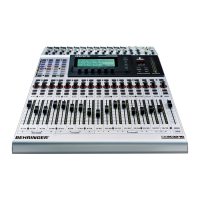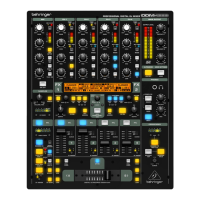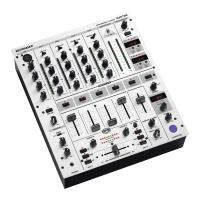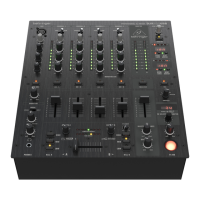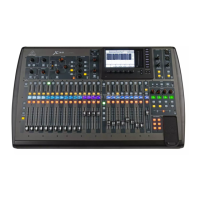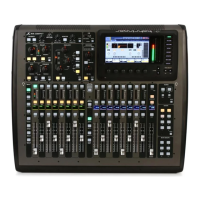27
5.2.9 Stereo Delay
The Stereo Delay produces different delays of up to 2.7 s for
the left and right sides of the output signal. The low-pass filter in
the feedback loop progressively reduces the high-frequency
content of the delay signals, which emulates the sound of a tape
delay unit used in the pre-digital age, which has become popular
again as part of the “vintage sound” trend.
Fig. 5.10: Parameters of Stereo Delay algorithm
Delay-L (0 to 2,700 ms)
This parameter controls the delay for the left effect channel.
Feedback-HP (20 Hz to 10 kHz)
Controls the cutoff frequency for a high-pass filter acting on
the effect signal.
Delay-R (0 to 2,700 ms)
This parameter controls the delay for the right effect channel.
Feedback-LP (100 Hz to 20 kHz)
Controls the cutoff frequency for a low-pass filter acting on
the effect signal.
Feedback-L (0 to 99%)
This parameter determines the feedback amount (in percent)
for the signal portion fed into the left effect input.
Feedback-R (0 to 99%)
This parameter determines the feedback amount (in percent)
for the signal portion fed into the right effect input.
5.2.10 Echo
Similar to the stereo delay effect, the Echo algorithm produces
delayed repetitions of the input signal, however, here you can
also adjust the feedback delays, which allows for very complex
delay patterns.
Fig. 5.11: Parameters of Echo algorithm
Delay-L (0 to 1,800 ms)
This parameter controls the delay for the left effect channel.
Feedback-HP (20 Hz to 10 kHz)
Controls the cutoff frequency for a high-pass filter acting on
the feedback signal.
Delay-R (0 to 1,800 ms)
This parameter controls the delay for the right effect channel.
Feedback-LP (100 Hz to 20 kHz)
Controls the cutoff frequency for a low-pass filter acting on
the feedback signal.
Feedback Delay-L (0 to 900 ms)
This parameter determines the delay for the left signal portion,
before it is fed into the left effect input.
Feedback (0 to 99%)
Feedback controls the number of repetitions.
Feedback Delay-R (0 to 900 ms)
This parameter determines the delay for the right signal portion,
before it is fed into the right effect input.
Input Gain-R (0 to 100%)
This parameter exchanges the feedback paths and attenuates the
input for the right-side repetitions, so as to create ping-pong echoes.
5.2.11 Stereo Chorus
This effect algorithm uses a low-frequency oscillator (LFO) to
produce a subtle and constant up/downward modulation of the
pitch and delay time of the effect signal, which creates a
charming detune or chorus effect. As this effect is used so
frequently and in such a variety of signal-widening applications,
any recommendation given here would mean a limitation of its
uses.
Fig. 5.12: Parameters of Stereo Chorus algorithm
Wave (Sine/Tri)
The Wave parameter determines the shape of the modulating
waveform (sine or triangle).
LFO Speed (0.05 to 20 Hz)
The LFO Speed parameter controls the speed (frequency) of
the modulating signal.
Mod Depth (0 to 100%)
This parameter governs the modulation depth, i. e. the amplitude
of the modulating signal.
Mod Delay (5 to 100 ms)
Mod Delay controls the delay of the modulated signal.
Stereo Phase (45, 90 and 180°)
This parameter determines the phase shift of the modulating
waveform between the left and right channels.
5.2.12 Stereo Flanger
This effect algorithm also uses a LFO. The input signal is delayed
and the delay time is modulated by the LFO. The delayed signal is
fed back to create resonances of variing frequencies. It is often
used for guitars and electric pianos, but can also be employed
for a variety of other signal sources, such as cymbals, bass,
remixes, etc.
Fig. 5.13: Parameters of Stereo Flanger algorithm
Wave (Sine/Tri)
The Wave parameter determines the shape of the modulating
waveform (sine or triangle).
Feedback (-99 to +99%)
Feedback controls the portion of the effect signal that is fed
back to the effect block. Positive and negative values produce
contrasting flanging characters!
LFO Speed (0.05 to 20 Hz)
The LFO Speed parameter controls the speed (frequency) of
the modulating signal.
Feedback-LP (200 Hz to 20 kHz)
Feedback-LP adjusts the cutoff frequency of a low-pass filter
acting on the feedback signal.
Mod Depth (0 to 100%)
This parameter determines the modulation depth, i. e. the
amplitude of the modulating signal.
Mod Delay (0.5 to 50 ms)
Mod Delay controls the delay of the modulated signal.
Stereo Phase (45, 90 and 180°)
This parameter determines the phase shift of the modulating
waveform between the left and right channels.
5. EFFECTS PROCESSORS

